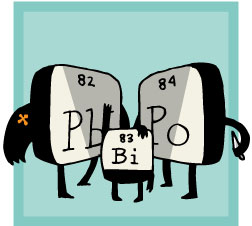Blogging the Periodic Table

Bismuth sits in a funny spot on the periodic table, at the turning point of what I call "poisoner's corridor." It cleaves the periodic table into two sets of dangerous elements. To the left of and above bismuth sit the conventional, retching-and-deep-pain poisons familiar to mystery buffs and EPA officials—the likes of arsenic, lead, and mercury. Especially deadly is the element two doors down from bismuth, Element 81, thallium. It's sometimes called the "poisoner's poison," the poison used by people who get an almost aesthetic pleasure from using chemistry to kill.
The notorious British serial killer Graham Frederick Young got his start by poisoning his family and friends with bismuth's neighbor to the north, antimony, but by the time he was in his midteens, Young had graduated to lacing meals and tea with thallium. Thallium does its dastardly work, in part, by unstitching the bonds that hold proteins together, and it does so quickly and efficiently.
Saddam Hussein employed thallium, too. In fact, two children of Iraqi fighter pilots died in early 2008 after eating a birthday cake laced with thallium, presumably poisoned (though no one knows for sure) by former Baath Party members. Russian soldiers working at an old Cold War weapons depot in 1994 found a canister of white powder laced with this element. Despite not knowing what it was, they powdered their feet with it and blended it with their tobacco. A few reportedly even snorted it.
On the other side of bismuth begins a new type of poison in poisoner's corridor—the scorching radioactive poisons. The most notable examples here are radon and (if you think about the periodic table wrapping around and continuing on the far left side) radium, which have each killed scores of people. The radioactive element right next to bismuth, polonium, has killed far fewer. But what polonium lacks in numbers it makes up for in infamy.
Polonium is frankly pretty useless, and no country in the world except Russia bothered to refine it by the late 2000s. That's why it was awfully suspicious when an ex-KGB official named Alexander Litvinenko died of polonium poisoning in late 2006. The story started when Litvinenko—who became a writer after leaving the KGB and accused the Kremlin of ordering people's executions—ate lunch at a sushi restaurant one day in London and began to feel ill.
At the hospital, doctors assumed he'd been given a lethal dose of thallium. This was partly because the symptoms matched thallium poisoning (including losing his hair, even his eyebrows). But also because no one thought to search for polonium—toxicologists had simply never heard of anyone using it as a murder weapon. But after Litvinenko's death, the autopsy revealed staggeringly high levels of Element 84. The polonium hit remains a one-off crime so far but has already taken its place as one of the most notorious murders in the annals of the periodic table.
And finally, what of bismuth itself, the turning point of poisoner's corridor? Is it a retching-and-deep-pain poison or a newfangled nuclear one—possibly both? Actually, it's neither. Despite the disreputable company it keeps, bismuth is harmless. In fact, it's medicinal: Doctors prescribe it to soothe ulcers, and it's the "bis" in hot-pink Pepto-Bismol. Overall, it seems like the most out-of-place element on the periodic table, a gentleman among scoundrels.
Like Slate on Facebook. Follow us on Twitter.